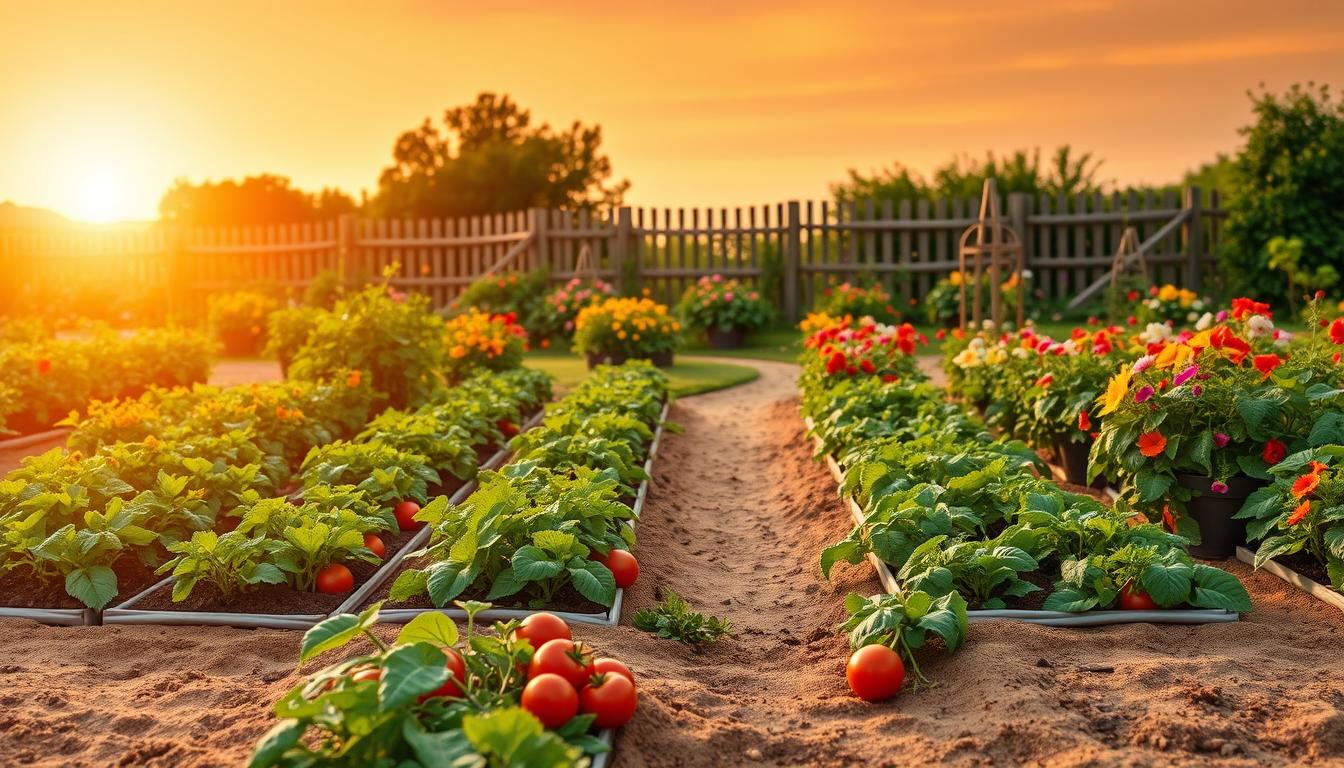Starting a vegetable garden can feel overwhelming, especially if you’re new to it. But with the right approach, it doesn’t have to be. Garden mapping is a simple yet powerful tool that can help you visualize your space and plan effectively. Lori, with 18 years of experience, has turned this method into a proven way to create thriving growing areas.
Begin with a small space, like a 10’x10’ plot, to build confidence. This year, you can make it different by focusing on location, plant choices, and maintenance. Visualizing your success through a garden map not only reduces stress but also boosts your motivation.
Resources like spacing guides and success stories from Three Acre Farm can inspire you. Ready to take the next step? Explore the “Backyard Cutting Garden 101” course for deeper insights.
Key Takeaways
- Garden mapping simplifies planning and reduces overwhelm.
- Start small to build confidence and avoid frustration.
- Visualizing your space boosts motivation and success.
- Focus on location, plant choices, and maintenance.
- Use resources like spacing guides for better results.
Why Garden Mapping is Essential for a Successful Vegetable Garden
Visualizing your planting area can make all the difference in your harvest. A garden map helps you organize your space, ensuring every plant gets the care it needs. This year, take the guesswork out of planting and enjoy better results.
One of the biggest challenges for beginners is seed catalog overwhelm. A map lets you visually organize your choices, making it easier to decide what to grow. It also helps you calculate the exact number of plants, so you don’t overbuy or waste resources.

Tracking microclimates within your space is another advantage. Some areas may get more sun or shade, and a map helps you place plants where they’ll thrive. Documenting successes and failures each year also improves your planning for future seasons.
Companion planting is easier with a visual guide. Pairing plants that benefit each other can boost growth and deter pests. Additionally, crop rotation prevents soil depletion, especially for families like brassicas and solanaceae.
Finally, a map helps you avoid common issues like overcrowding or wasted space. With a clear plan, you can maximize your harvest and enjoy a more organized, stress-free experience.
Choosing the Perfect Location for Your Vegetable Garden
Finding the right spot for your vegetable patch is the first step to a thriving harvest. Your location can determine how well your plants grow and how much effort you’ll need to put into maintenance. Let’s break down the key factors to consider when selecting the ideal area.
Assessing Sunlight and Water Access
Most vegetables need at least 8 hours of sunlight each day. Use smartphone apps to track sun patterns in your space. This helps you identify the sunniest spots and avoid shady areas.
Water access is equally important. Ensure your hose can reach every corner of your planting area. If you’re renting a community plot, check the water source’s proximity before committing.
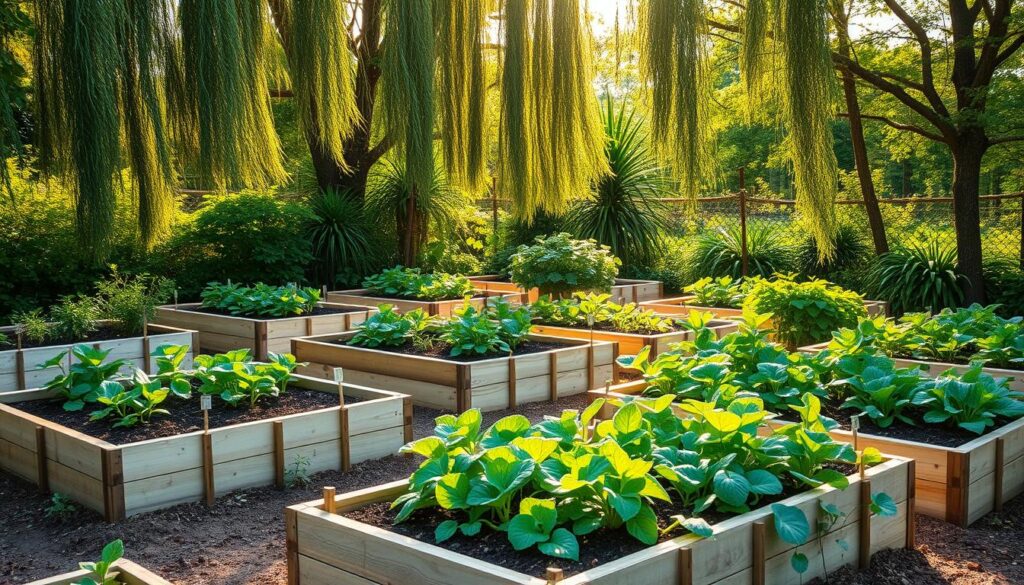
Soil Quality and Raised Bed Options
Healthy soil is the foundation of a successful growing space. Test your soil’s drainage using the jar test method. If you have clay soil, mix in sand and compost to improve its texture.
For better control over soil quality, consider raised beds. They’re easy to build with materials like cinder blocks and allow you to customize the soil mix. Position your beds north-south for optimal sunlight exposure.
If space is limited, repurpose patio containers or try Lori’s vertical planting system. Avoid low-lying areas that may become frost pockets, as they can harm your plants.
How to Measure and Sketch Your Garden Space
Accurately measuring your growing area is the foundation of a well-organized planting plan. Whether you’re working with a small plot or a larger space, taking the time to sketch your layout ensures every plant has room to thrive. This step-by-step guide will help you create a clear and functional map of your area.
Using Graph Paper for Precision
Graph paper is a simple yet effective tool for creating a detailed map. Start by measuring your space and using a scale of 1″=1′ to represent your area accurately. This method allows you to plan bed layouts, pathways, and plant placements with precision.
Use colored pencils to code different plant types or sections. For example, mark perennial beds in one color and annuals in another. This visual coding makes it easier to track your planning over time.
Reusable templates are a great way to save time. Create a base template for your space and update it each season. This approach is especially useful for odd-shaped beds or areas with unique features.
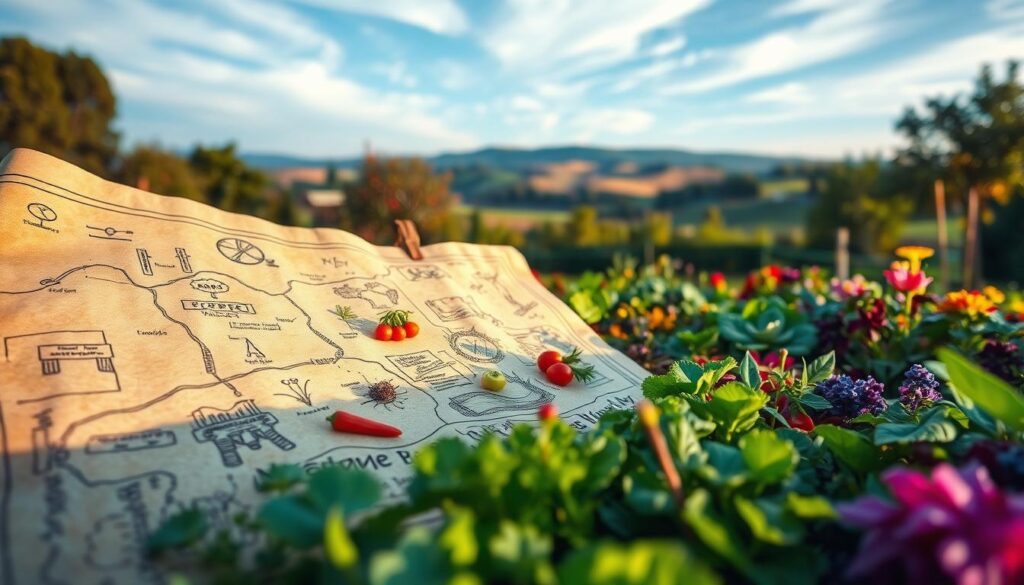
Digital Tools for Garden Mapping
For those who prefer a tech-savvy approach, digital tools offer advanced features. Google Earth Pro’s timeline feature lets you import satellite images of your space. You can layer crop rotation plans or use geometric formulas to calculate bed areas.
Google Drawings is another excellent option. Import your satellite image and sketch directly on it. This method is ideal for sharing your map with others or making quick adjustments.
Smartphone apps can also simplify the process. Use measuring apps to double-check dimensions or integrate Google Maps for a bird’s-eye view of your space. Digital tools are perfect for those who want to experiment with different layouts before committing.
| Method | Pros | Cons |
|---|---|---|
| Hand-Drawn | Simple, no tech required, customizable | Time-consuming, less precise |
| Digital | Precise, easy to edit, shareable | Requires tech skills, potential learning curve |
Whether you choose graph paper or digital tools, the key is to create a map that works for you. A well-planned space sets the stage for a successful growing season.
Selecting the Right Plants for Your Garden
Choosing the right plants can transform your growing space into a thriving oasis. Whether you’re a beginner or looking to expand your skills, focusing on the right species ensures a successful and enjoyable experience. Start with a curated list of easy-to-grow options and gradually introduce new varieties each year.
Beginner-Friendly Vegetables and Flowers
For those just starting, it’s best to stick with no-fail plants like sunflowers and zucchini. These species are hardy, require minimal care, and provide quick results. Adding pollinator-attracting flowers like marigolds or cosmos can also enhance your space and support beneficial insects.
When planning your plant list, consider maturity timelines and frost dates. This ensures your crops have enough time to grow before the first frost. Using a seed inventory spreadsheet can help you stay organized and avoid overbuying.
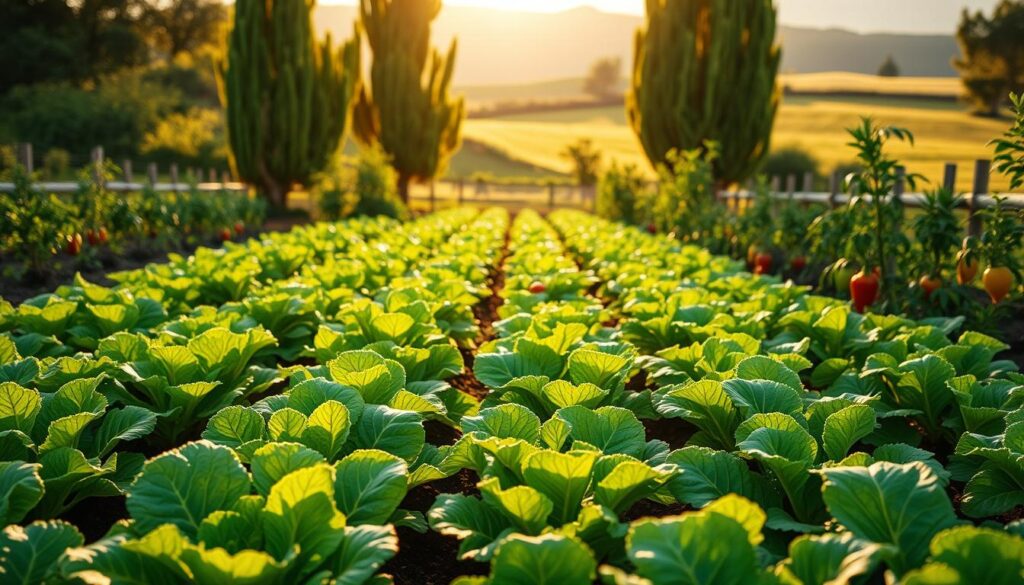
Understanding Plant Spacing and Growth Requirements
Proper plant spacing is crucial for healthy growth. Overcrowding can lead to competition for resources, while too much space wastes valuable area. Use a square foot planting chart to maximize efficiency in your beds.
For flowers, tighter spacing can result in longer stems, which is ideal for cutting gardens. Climbers like beans or cucumbers benefit from vertical supports, saving ground space and improving air circulation. Avoid invasive species like mint, which can quickly take over your area.
Comparing seeds versus starter plants can also help you decide what’s best for your needs. Seeds are cost-effective and offer a wider variety, while starter plants save time and reduce initial effort. Heirloom varieties are a great choice for their unique flavors and adaptability.
By focusing on these factors, you’ll create a well-planned and productive space that grows with you each season.
Creating a Planting Plan for Your Garden Map
Planning your planting strategy is the key to a thriving and organized space. A well-designed plan ensures your crops grow efficiently and healthily. By grouping plants by harvest season and incorporating crop rotation, you can maximize your harvest and minimize effort.
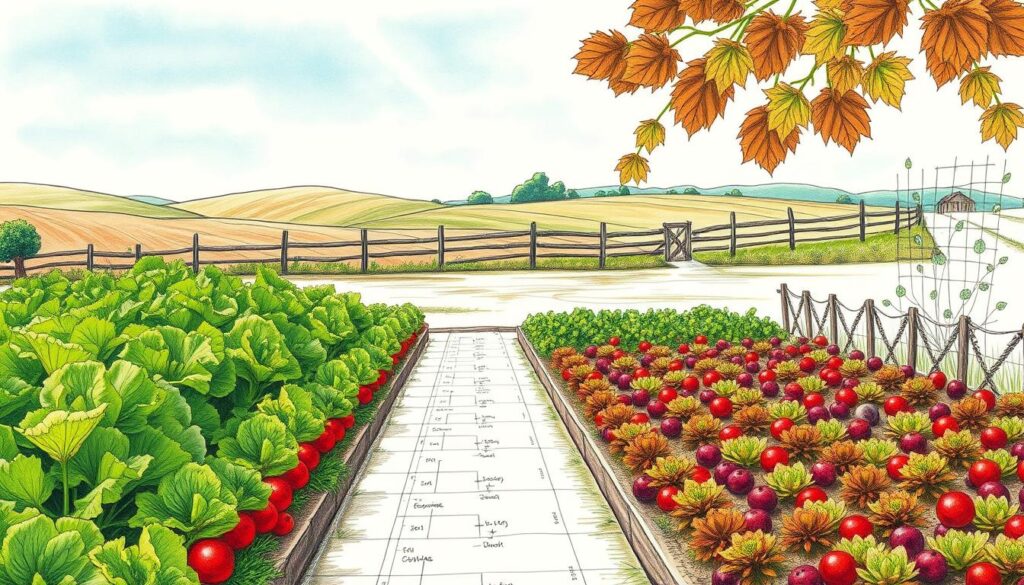
Grouping Plants by Harvest Season
Organizing your crops by season helps you make the most of your space. Design spring and fall planting zones to ensure continuous growth. For example, plant cool-weather crops like lettuce in early spring and follow them with warm-weather plants like tomatoes.
Create a succession planting calendar to track when each crop will be ready. This allows you to plant quick-growing crops like radishes between slower-growing ones. Use sticky notes for flexible planning, so you can adjust your schedule as needed.
Incorporating Crop Rotation into Your Plan
Crop rotation is essential for maintaining soil health. Follow a 4-year rotation cycle to prevent nutrient depletion and reduce pest buildup. For instance, rotate brassicas like broccoli with legumes like beans each year.
Color-coding by plant family makes it easier to track rotations. Integrate cover crops like clover into your plan to enrich the soil during off-seasons. This strategy also helps control weeds and improve soil structure.
| Plant Family | Rotation Cycle | Example Crops |
|---|---|---|
| Brassicas | Year 1 | Broccoli, Cabbage |
| Legumes | Year 2 | Beans, Peas |
| Solanaceae | Year 3 | Tomatoes, Peppers |
| Root Crops | Year 4 | Carrots, Beets |
By following these steps, you’ll create a plan that ensures healthy crops and a productive season. Whether you’re a beginner or an experienced grower, these strategies will help you make the most of your space and resources.
Conclusion: Turn Your Garden Map into a Reality
Bringing your planting vision to life is easier than you think. Break the process into weekend projects to avoid feeling overwhelmed. A phased approach lets you focus on one area at a time, ensuring success throughout the year.
Protect your paper map by treating it for weather resistance. This ensures it lasts all season. Consider hosting a community mapping party to share ideas and inspire others. Download free templates using the QR code below to get started.
Remember to update your plans each year based on what worked and what didn’t. This keeps your space thriving and your plants healthy. For more tips, explore the “How to Grow” series on our blog.
Ready to take the next step? Enroll in the Cut Flower Confidence course to master your skills. Lori believes in you—your first harvest is closer than you think!
For beginners, check out this guide on gardening for beginners to build your confidence. Happy planting!

